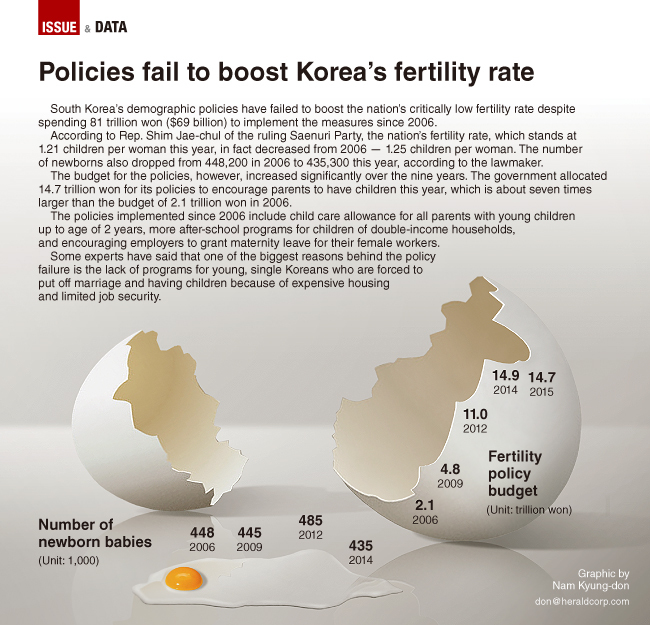[Graphic News] Policies fail to boost South Korea’s fertility rate
By Claire LeePublished : Sept. 14, 2015 - 18:42

South Korea’s demographic policies have failed to boost the nation’s critically low fertility rate despite spending 81 trillion won ($69 billion) to implement the measures since 2006.
According to Rep. Shim Jae-chul of the ruling Saenuri Party, the nation’s fertility rate, which stands at 1.21 children per woman this year, in fact decreased from 2006 -- 1.25 children per woman. The number of newborns also dropped from 448,200 in 2006 to 435,300 this year, according to the lawmaker.
The budget for the policies, however, increased significantly over the nine years. The government allocated 14.7 trillion won for its policies to encourage parents to have children this year, which is about seven times larger than the budget of 2.1 trillion won in 2006.
The policies implemented since 2006 include child care allowance for all parents with young children up to age of 2 years, more after-school programs for children of double-income households, and encouraging employers to grant maternity leave for their female workers.
Some experts have said that one of the biggest reasons behind the policy failure is the lack of programs for young, single Koreans who are forced to put off marriage and having children because of expensive housing and limited job security.
Gender inequality in the nation’s labor force has also been also pointed out. According to Rep. Min Hyun-joo of the ruling Saenuri Party, some 260,000 women were fired from their work while taking their maternity leave in the last five years.
The government expects that the nation’s military would be short of 84,000 soldiers by 2030, and the health care cost for the elderly would result in a deficit of 47.7 trillion won ($44 billion) in the national health insurance fund in the same year, if the current fertility rate continues.
The government is scheduled to announce its revised demographic policies for the next five years -- 2016-2020 -- next month.






![[From the Scene] Monks, Buddhists hail return of remains of Buddhas](http://res.heraldm.com/phpwas/restmb_idxmake.php?idx=644&simg=/content/image/2024/04/19/20240419050617_0.jpg&u=20240419175937)







![[From the Scene] Monks, Buddhists hail return of remains of Buddhas](http://res.heraldm.com/phpwas/restmb_idxmake.php?idx=652&simg=/content/image/2024/04/19/20240419050617_0.jpg&u=20240419175937)

![[KH Explains] Hyundai's full hybrid edge to pay off amid slow transition to pure EVs](http://res.heraldm.com/phpwas/restmb_idxmake.php?idx=652&simg=/content/image/2024/04/18/20240418050645_0.jpg&u=20240419100350)

![[Today’s K-pop] Illit drops debut single remix](http://res.heraldm.com/phpwas/restmb_idxmake.php?idx=642&simg=/content/image/2024/04/19/20240419050612_0.jpg&u=)